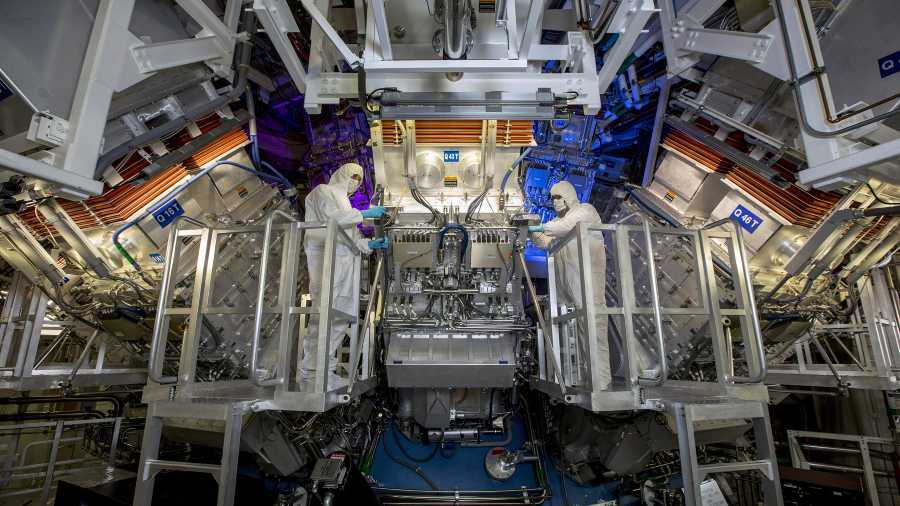Scientists have come tantalisingly close to reproducing the power of the sun — albeit only in a speck of hydrogen for a fraction of a second.
Researchers at the Lawrence Livermore National Laboratory in California, US, recently reported that by using 192 gigantic lasers to annihilate a pellet of hydrogen, they were able to ignite a burst of more than 10 quadrillion watts of fusion power. This is energy released when
hydrogen atoms are fused into helium, the same process that occurs within stars.
Indeed, Mark Herrmann, Livermore’s deputy programme director for fundamental weapons physics, compared the fusion reaction to the 170 quadrillion watts of sunshine that bathe Earth’s surface.
“This is about 10 per cent of that,” Herrmann said. And all of the fusion energy emanated from a hot spot about as wide as a human hair, he said.
The burst — essentially a miniature hydrogen bomb — lasted only 100-trillionths of a second. Still, that spurred a burst of optimism for fusion scientists who have long hoped that fusion could someday provide a boundless, clean energy source for humanity.
“I’m very excited about this,” said Siegfried Glenzer, a scientist at the SLAC National Accelerator Laboratory in Menlo Park, California, US, who led the initial fusion experiments at the Livermore facility years ago but is not currently involved in the research. “This is very promising for us, to achieve an energy source on the planet that won’t emit CO2.”
The success also signified a moment of redemption for Livermore’s football stadium-size laser apparatus, which is named the National Ignition Facility, or NIF. Despite an investment of billions of dollars — construction started in 1997, and operations began in 2009 — the apparatus initially generated hardly any fusion at all. In 2014, Livermore scientists finally reported success, but the energy produced then was minuscule — the equivalent of what a 60-watt lightbulb consumes in five minutes.
On August 8, the burst of energy was much greater — 70 per cent as much as the energy of laser light hitting the hydrogen target. That is still a losing proposition as an energy source, consuming more power than it produces. But scientists are confident that further jumps in energy output are possible with fine-tuning of the experiment.
Herrmann said that normally, Livermore scientists would not talk until after a scientific paper describing the findings had been published. But these findings “have been spreading like wildfire,” he said, “and so we thought it would be better to put some facts out there now.”
Stephen Bodner, a retired plasma physicist who has long been a critic of NIF, offered congratulations. “I am surprised,” he said. “They have come close enough to their goal of ignition and break-even to call it a success.”
More promisingly, the fusion reactions for the first time appeared to be self-sustaining, meaning the torrent of particles flowing outward from the hot spot at the centre of the pellet heated surrounding hydrogen atoms and caused them to fuse as well.
Riccardo Betti, chief scientist at the University of Rochester’s Laboratory for Laser Energetics, compared it to how an automobile engine works. “You deliver energy in a very small fraction of the fuel through a spark in the spark plug, and then that energy gets amplified by the combustion of the fuel,” he said. “So, the same thing happened in the Livermore experiment.”
Herrmann was more circumspect, noting that the results fell short of the definition set by a National Academy of Sciences report in 1997: that the fusion energy produced needed to exceed the amount of energy delivered by the lasers to the hydrogen. “We’re on the threshold,” he said.
The Livermore scientists said they needed to analyse their results more carefully before making more detailed claims.
Glenzer, however, said he was sure that the fusion had propagated. The fusion reactions produced a torrent of subatomic particles known as neutrons, more than instruments could count.
The improved fusion results also help the National Ignition Facility fulfill its primary use: to verify that nuclear weapons work. After the United States suspended underground nuclear testing in 1992, lab officials argued that some way was needed to verify the computer models that replaced testing.
Herrmann said that within 24 hours of the latest experiment, someone working on the programme of modernising nuclear weapons contacted the NIF team. “They’re interested in applying this to important questions that they have,” he said.
NIF itself cannot serve as a blueprint for a future power plant. Its lasers are inefficient, and it can fire only about once a day. A laser fusion power plant would need to vaporise hydrogen pellets at a rate of several per second.
Glenzer said SLAC was working on a laser system that would work at lower levels of power but fire much more rapidly. He said he hoped fusion, overshadowed in recent years by solar energy and other energy technologies, would again gain prominence in efforts to replace fossil fuels.
Federal financing for fusion research is low, even as the Biden administration has put emphasis on reducing climate change.
“Sometimes it happens, in the worst year of your funding, you get the greatest results,” Glenzer said.
NYTNS










